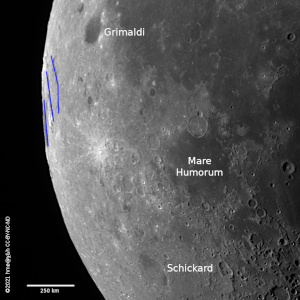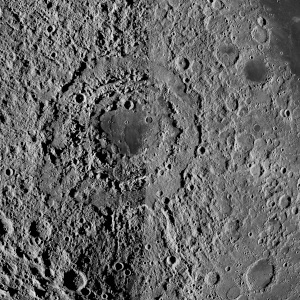
{
Practical astronomy
|
Astronomy
|
The Moon
|
The physical Moon
|
The Lunar 100
}
Lunar #80: Mare Orientale
Mare Orientale lies on the western limb of the Moon. This may seem odd, as the orient is another word for the East. Since the name was given, astronomers have changed their mind about East and West. Let us look first at the old convention: On the ground (of Earth) East is right of North. But on the sky (looking up) this is reversed. Imagine looking at the Moon high in the South (assuming you are in the northern hemisphere). The North Celestial Pole is upward and the East point of the horizon is to the left. This is the convention astronomers use for depictions of the sky: North is up and East is left. For centuries, objects like Sun, Moon and planets were considered part of this sky and so the lunar East was on the left, where Mare Orientale is.
In the 20th century, astronomers reversed this terminology. These bodies are no longer seen as discs pasted onto our sky, but as bodies in space, with their own rotation and their own coordinate grids of longitude and latitude. The terrestrial definition of East as right when North is up, should then apply. And so it happens that the lunar orient is now in the selenographic West.
Wood lists Mare Orientale as 930 km in diameter (2004a, 2012a, Hardwick 2013a). The Atlas virtuel de la Lune (Chevalley and Legrand 2012a) states only 300 km, but goes on to describe it as "central part of a basin of 900 km in diameter", and with two mountainous rings, the Montes Cordillera and Montes Rook.
The Mare is very rarely seen and requires extreme libration in longitude. If you have the map by Antonín Rükl available on which the Lunar 100 have been added with red numbered markers, then you will find that this is one of two entries missing.
Refer to Wood's list (2004a and 2012a) and to his notes (cf. Hardwick 2013a). Compare your observation with the Atlas virtuel de la Lune (Chevalley and Legrand 2012a). In this atlas, at high resolution, in general, consider a photographic texture like the LRO WAC mosaic as well as the synthesised topography of the LOLA Kaguya Shade texture. For regions near the lunar limb, changing from the foreshortened Earthlings' perspective to the vertical view down on the Moon can be instructive.
Images:
- The Moon on 2021-12-27, stacked from 5 raw frames taken with a Telementor II refractor of f = 840 mm and f/D = 13.3 and Canon EOS 600Dα camera. Unsharp mask. Libration was −6.7° in longitude and −4.6° in latitude; the phase was −48% (Last Quarter).
- Dto., annotated and with scale. The three lines denote the Mare proper, the Lacus Veris inside the Montes Rook, and the Lacus Autumni inside the Montes Cordillera.
- Screenshot of the face-on view from Atlas virtuel de la Lune (Chevalley and Legrand 2012a).



